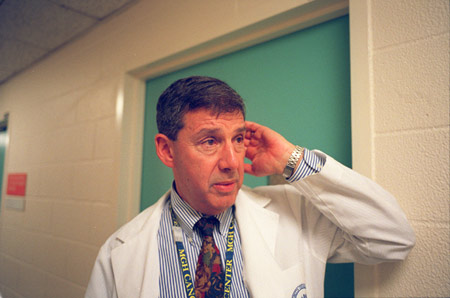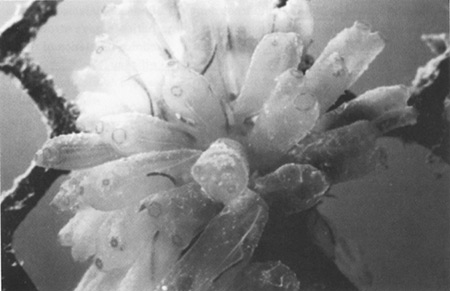Scientists seek sea squirts by the seashore

A powerful cancer drug found in the tissues of sea squirts is being tested on a variety of cancers. Trials conducted in the United States and Europe show that the compound has promising activity against connective tissue, breast, ovary, and prostate tumors.
In addition to collecting the squirt, known as Ecteinascidia turbinate, from sea bottoms around the world, a Spanish company, PharmaMar, has established an underwater farm on which the tubelike creatures are being raised. Tests on hundreds of patients in Europe have been encouraging enough for the company to apply for approval to market the drug, which they call ET-743. If received, PharmaMar expects to begin selling the drug in Europe by the end of this year for treatment of soft-tissue sarcomas, cancers affecting blood vessels, muscles, tendons, and other connective tissues including those that hold internal organs in place.
In the United States, researchers at three Harvard University-affiliated hospitals – Massachusetts General Hospital, Dana-Farber Cancer Institute, and Brigham and Women’s Hospital – have been testing the drug on patients with breast, ovarian, and prostate cancer. “Tests show that the drug has been active enough to expand these trials,” says Bruce Chabner, a professor of medicine at Harvard Medical School.
Two years ago, Elias J. Corey, Sheldon Emery Professor of Chemistry at Harvard, managed to make the drug synthetically. He called it “the most complex molecule ever made on a commercial scale.”
PharmaMar says that a harvest of about 95,000 pounds of sea squirts yields a scant 3 ounces of the drug. But it is so incredibly powerful, only 0.05 ounce is enough to treat 100 patients. According to Corey, a mere 11 pounds of the drug would satisfy world demand for about a year.

Tumors shrunk
Sea squirts are vase-shaped sacs of tough tissue that filter food particles from the water with the help of two siphonlike openings at the top. Kenneth Rinehart, a chemist at the University of Illinois, discovered ET-743 (ecteinascidin) in squirts he collected in the West Indies in the late 1980s. PharmaMar licensed the drug in 1994 and began testing it in humans two years later. Five tests for safety, so-called Phase I trials, were done on 188 patients in the United Kingdom, France, and the United States.
In the beginning, ET-743 appeared to cause liver problems. However, this side effect “turned out to be reversible and manageable with repeated treatments,” Chabner says.
PharmaMar moved on to Phase II tests, conducted to determine how well a drug works, in 1999. At the Harvard hospitals, these trials were led by George Demetri of the Dana-Farber Cancer Institute and David Ryan of Massacusetts General. Of the first 101 people with advanced soft-tissue cancers who took the drug, tumor shrinkage occurred in 20 and tumor growth stopped in another 31. In other Phase II trials, including those done in Europe, 10-15 percent of patients experienced tumor shrinkage, and the disease stopped progressing in another 30 percent.
Chabner refers to the results as “modest, but encouraging.” He adds that “ET-743 can be given with relative safety to people without liver disease, and these people have a reasonably good overall survival rate.”
The results also impressed PharmaMar enough for the company to seek approval this year to market the drug in Europe, according to Immacuada Abella, the company’s director of marketing and sales.
Johnson & Johnson has licensed the drug for sale in the United States. However, it will take several more years to get approval in this country because the Food and Drug Administration requires Phase III trials, which compare new drugs to standard treatments in hundreds of patients.
A drug called doxorubicin is now the first line of defense against most soft-tissue cancers in the United States, but only approximately 15 percent of patients respond to it, Chabner says. Treatment can halt progression of the disease, but in most of these patients the cancer returns and becomes resistant to the drug.
“There’s clearly a need and place for a better drug,” Chabner notes.
Shooting at bigger targets
About 7,500 new cases of soft-tissue cancer occur in the United States each year. That’s a small number compared with new cases (more than 400,000) and deaths (84,000) from breast, ovarian, and prostate cancer combined. Tests conducted in Europe show that all three types of tumors respond to the sea squirt drug. However, only 20-30 patients with each cancer have been tested, and tumors have shrunk in only five to eight cases of each cancer.
“These results need to be bolstered by trials with more patients, and the efficacy of ET-743 must be compared with drugs now in use,” Chabner comments. The three Harvard hospitals are finalizing plans to go ahead with such tests.
In addition to its potency, one of the unique things about ET-743 is the way it attacks tumors. The majority of drugs used to fight cancer are most effective against tumors that have lost the ability to repair their DNA, or genetic material. ET-743, in contrast, is most active in tumors where DNA repair goes on uninterrupted. Proteins that do such repairs create breaks in the DNA strands when they cut out unwanted pieces. The sea squirt compound seems to prevent repair proteins from mending the breaks.
“This action suggests that ET-743 would be most useful as a complement to other drugs,” Chabner believes. “I doubt that any single drug is going to cure cancer.” As an example, he cites cisplatin, which works best in tumors lacking a capability to repair their DNA. In theory, this combination would be a one-two punch; cisplatin would kill repair-deficient cells and ET-743 would kill cells that survive cisplatin.
“Among compounds being studied to kill cancer cells,” Chabner concludes, “ET-743 is one of the most interesting.” He compares it with paclitaxel (Taxol), another natural compound derived from the bark of certain yew trees and used to treat breast and ovarian cancers. Although ET-743 is hundreds of times more potent, Chabner says, “it is too early to say if it will be another paclitaxel.”
To me the sea is a continual miracle.
– Whitman




